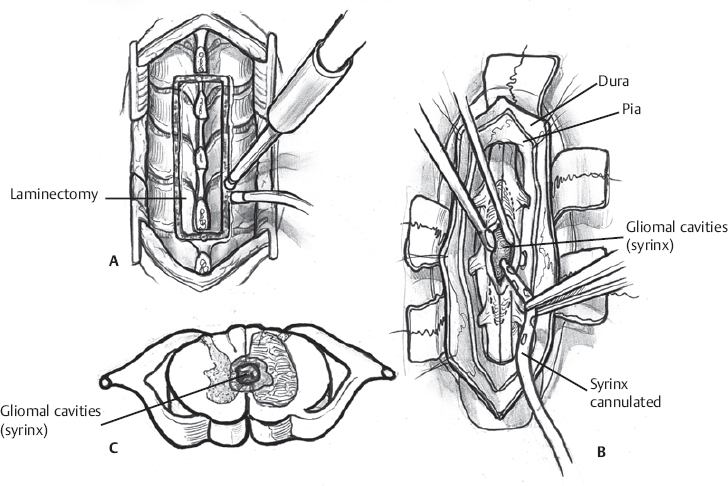♦ Preoperative
Operative Planning
- Obtain adequate imaging studies to rule out presence of an underlying mass lesion
- Magnetic resonance imaging (MRI) with and without gadolinium contrast
- Identification of the point where the syrinx is most superficial to the cord surface
- Shunt catheter should be placed in the most dependent portion of the syrinx, but above the level of injury in cases of traumatic syrinx
Equipment
- Major set-up
- Mayfield head clamp (for cervical or high thoracic cases)
- High-speed drill and Kerrison rongeurs
- Microinstrument set
- Silastic T-tube (Dow Corning, Midland, MI)
Operating Room Set-up
- Operating microscope with bridge attachment
- Monopolar and bipolar cautery
- Heparinized irrigating solution
- Dexamethasone
- Perioperative antibiotic coverage
- Somatosensory evoked potential and rectal-sphincter electromyography (optional)
♦ Intraoperative (Fig. 141.1)
Positioning
- Prone on the Jackson table or Allen table
- Alternatively, prone on a standard table with chest rolls and adequate padding to all pressure points
- Intraoperative imaging (x-ray or fluoroscopy) for localization prior to surgical site preparation
Planning of Incisions
- An approximate 15-cm midline incision centered on the level of interest
- Marking of the inferolateral rib cage in anticipation for possible syringopleural shunt
- Silastic T-tube removed and placed to soak in a bacitracin saline solution
Incision and Exposure
- Skin incised and paraspinal musculature is dissected along a subperiosteal plane with monopolar cautery
- Exposure and removal of the spinous process (by a Leksell rongeur) at the vertebral level of interest
- Laminectomy completed with high-speed drill or Kerrison rongeurs
- Exposure of the inferior aspect of the lamina above and the superior aspect of the lamina below
- Bone wax is applied to the bleeding bone edges for hemostasis
- Bipolar cautery utilized for control of any epidural bleeding
- Gelfoam soaked in thrombin is placed into the lateral epidural gutters
- Skin and surrounding area is covered with sterile towels
- Dura is elevated with a 4–0 Nurolon suture and incised with a no. 11 blade scalpel, leaving the arachnoid intact
- A dental instrument is placed into the subdural space, and the dural opening is extended in a rostrocaudal direction.
- Approximately 3 mm of dura is left unopened at the superior and inferior poles to facilitate dual closure at completion of the procedure.
- Dural edges are tacked to the paraspinal musculature with 4–0 Nurolon sutures
- Inspection of cord to identify most thinned portion followed by identification of the dorsal root entry zone
- Arachnoid is opened in a paramedian location and tacked to the dura with a 4–0 Nurolon suture
- Subarachnoid space is examined to identify any scaring and adhesions
- If significant adhesions are present, then a syringe-subarachnoid shunt is likely to fail, therefore a syringopleural or syringoperitoneal shunt should be performed.
< div class='tao-gold-member'> Only gold members can continue reading. Log In or Register to continue
Only gold members can continue reading. Log In or Register to continue
Stay updated, free articles. Join our Telegram channel

Full access? Get Clinical Tree







